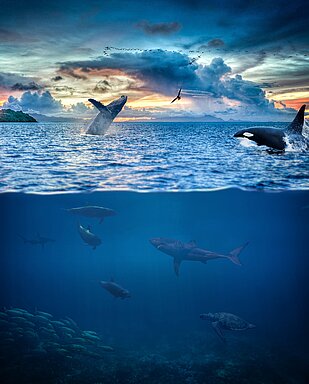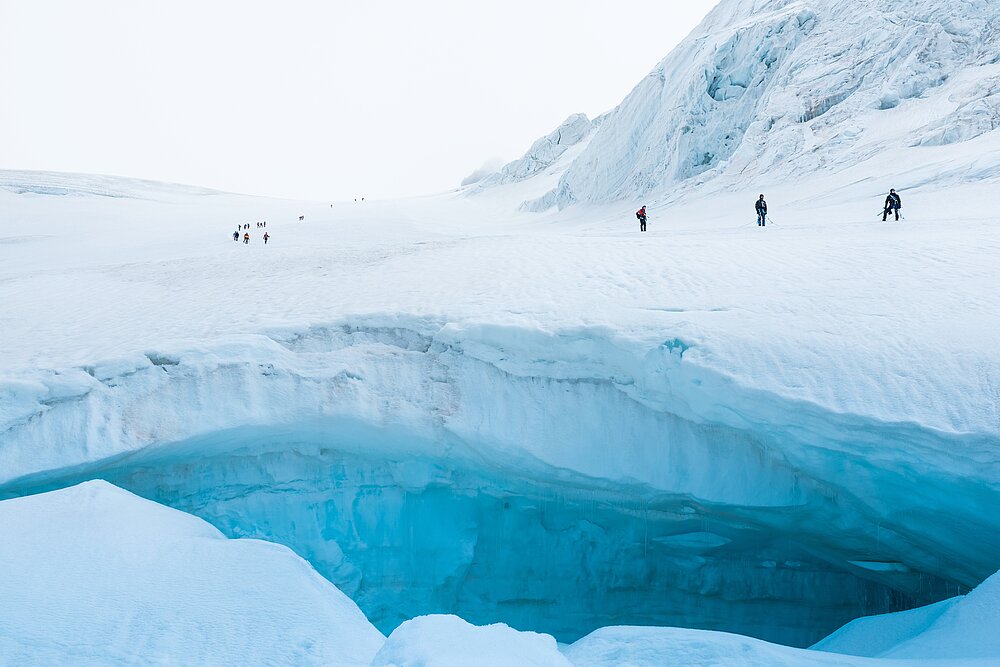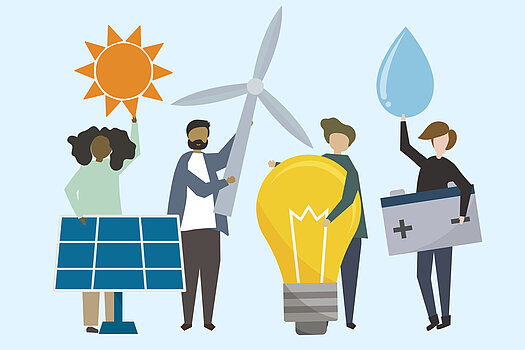Global strategies
Marine cloud brightening

Marine cloud-brightening is a technique that could increase the albedo of marine stratocumulus clouds and thus help mitigate global warming. One of the articles linked here (1) explains how wind-driven spray ships are used to release micrometer-sized droplets of seawater into the boundary layer beneath marine stratocumulus clouds, increasing their ability to reflect solar energy. The technique takes advantage of the Twomey effect which states, that multiple smaller droplets provide a better ability to reflect solar radiation than a smaller number of larger droplets. The spray vessels used for this purpose can be powered by carbon-neutral Flettner rotors, which double as convenient housings for the spray nozzles. The article estimates that to cancel out the thermal effects of a one-year increase in global CO2 levels, it would only take the equivalent of about 64-127 million dollars to build the technologies used to do so. This article provides information on the wind-driven spray ships, powered by Flettner rotors, used for this purpose.
This comparatively inexpensive method of curbing global warming also carries some risks, if applied uncritical, immediate and at the maximum, that cannot be seriously predicted. Another article linked here (2) includes studies showing that MCB can potentially cause changes in temperature and precipitation that can be both positive and negative depending on the region.
This is why you should explore such such efforts first only on a really small scale (e.g. grid of 3 x 3 ships each separated by 10 km) for some years so that everything is still fully reversible - this is called a climate mitigation strategy. It is essential to see the difference between geoengineering and climate mitigation strategies: Irreversible geoengineering is rather risky, careful exploring all options to mitigate climate in a reversible way (soon after exploration is stopped, all small climate effects fade off, too) is essential to find a bundle of different options for safe action in ten years, when global warming becomes ever more detrimental.
We are advocating to test a number of different climate protection strategies, so that we have a choice and can find the safest but also most climate preserving cocktail of countermeasures. Because the riskiest strategy in the fight against global warming is to do nothing at all due to possible negative effects and leave promising climate mitigation strategies such as MCB unexplored and untested.
Another article linked here provides information on possible field experiments that could help to better assess the impact of the MCB on climate. (3)
Marine biomass regeneration

The protection of the global whale population and other large marine animals is not primarily of such high importance, so that later generations can also go "whale watchching". Without exaggerating, it can be said that the protection and regeneration of large marine animals is essential for the stability of the entire ecosystem "sea" and beyond. In an article linked here (1), the role of wale is said to play a key role in a healthy marine ecology by bringing limiting nutrients to the ocean surface, when they release fecal matter there. These nutrients subsequently help to increase primary production, or photosynthesis, of the phytoplankton living there. A very important connection if you consider the numbers in another article linked here (2). There it is estimated that phytoplankton produces about 50% of the atmospheric oxygen. the microorganisms achieved this by sequestering atmospheric CO2 and converting it to O2, which recedes atmospheric CO2 levels and is thus an important climate mitigation strategy.
As the lowest link in the food chain, phytoplankton with its photosynthesis products provides the food basis for the entire marine fauna. Thus, it becomes clear that the ecosystem "sea" also represents a cycle, in which each link makes an important contribution to the preservation and stability. These processes are so finely tuned to each other that destabilization at one point always creates unpredictable problems at another, which, if overstimulated, can lead to the disintegration of the entire ecosystem.
Supplying phytoplankton directly and globally with industrial fertiliser for the purpose of climate mitigation is not an advisable strategy, as the consequences of this large-scale intervention are difficult to assess and even more difficult to control.
A very promising and natural approach is the ecological fertilisation of phytoplankton, by supporting the regeneration of the whale population. This is exactly what the Climate Repair Institute is currently implementing in a project to remove CO2 from the air. This project is led by Sir David King, who is supported as a collaboration partner by Thomas Dandekar, Head of the Department of Bioinformatics at the University of Würzburg.
In order to distribute the nutrients transported by the whales to the sea surface also on land, other actors are necessary. Another article linked here (3) informs about seabirds as well as anadromous fish, which migrate long distances up the rivers from the oceans to spawn, making a considerable contribution to distribute nutrients from the oceans back to the mainland. The article also shows how much the efficiency of this natural nutrient distribution pump has decreased, due to massive reduction of the actors involved.
One of the main culprits for this crisis is clearly the international fishing industry. So if you ask yourself as a private person what you can do against the progressive destabilisation of the marine ecosystem, the answer is as simple as it is clear. You should only consume sustainable fish, seafood and products made from them. As a consumer, you should also always be aware that a sustainability label on food is in no way a guarantee. It may seem that consuming fish from aquaculture is safe. But in most aquacultures, fish are fed fishmeal and fish oil. Unsustainable fishmeal, is mostly made from marine fish and also has to be produced in an industrial process. An article by Greenpeace provides more detailed information on this and other negative aspects of aquaculture (4).
Literature on marine cloud brightening
1. Sea-going hardware for the cloud albedo method of reversing global warming
Salter S, Sortino G, Latham J. Sea-going hardware for the cloud albedo method of reversing global warming. Philos Trans A Math Phys Eng Sci. 2008 Nov 13;366(1882):3989-4006. doi: 10.1098/rsta.2008.0136. PMID: 18757273. last accessed on: 15.06.22
2. Climate impacts of geoengineering marine stratocumulus clouds
Jones, A., Haywood, J., and Boucher, O. (2009), Climate impacts of geoengineering marine stratocumulus clouds, J. Geophys. Res., 114, D10106, doi:10.1029/2008JD011450. last accessed on: 15.06.22
3. Marine cloud brightening
Literature on marine biomass regeneration
1. Frontiers in Ecology and the Environment
Joe Roman,James A Estes,Lyne Morissette,Craig Smith,Daniel Costa,James McCarthy,JB Nation,Stephen Nicol,Andrew Pershing,Victor Smetacek. Whales as marine ecosystem engineers. Frontiers in Ecology and the Environment. 2014, July 03. last accessed on: 17.06.22
2. Fractional order oxygen-plankton system under climate change
Ozarslan R, Sekerci Y. Fractional order oxygen-plankton system under climate change. Chaos. 2020 Mar;30(3):033131. doi: 10.1063/1.5129766. PMID: 32237788. last accessed on: 17.06.22
3. Marine Biomass Regeneration
Project from Centre for Climate Repair at Cambridge, 17.05.2022. last accessed on: 14.02.2023
4. Global nutrient transport in a world of giants
Doughty et al., (2016) Global nutrient transport in a world of giants. 2015 October, 26. last accessed on: 18.06.22
5. Challenging the Aquaculture Industry on Sustainability
Michelle Allsopp, Paul Johnston and David Santillo at Greenpeace Research Laboratories, University of Exeter, UK. January, 2008 by Greenpeace International. last accessed on: 21.06.22
Green kerosene

The combustion of crude oil-based fuels, such as kerosene, releases CO2, nitrogen oxides and other particulates directly into the Earth's lower atmospheric layers, the troposphere. (1) Although aviation only accounts for about three to five percent of total emissions of harmful greenhouse gases, the sector is experiencing strong annual growth, making the development of climate-friendly kerosene increasingly interesting from a climate protection perspective. (1)
One important approach to this is so-called power-to-liquid (PtL), i.e. the use of solar and wind energy to produce fuels from water and CO2. (2) Even though the cost of producing PtL can be expected to fall steadily, the production costs will still be significantly higher than the prices of the fossil fuels currently used. (3) A major challenge, is to reduce the cost of capturing CO2 from the air through what is known as "direct air capture" (DAC). In a publication on the prospects of DAC, half of the experts surveyed cited the lack of supportive policies as the main obstacle to the development of DAC projects. (4) Even among the best prospects for developing DAC technology, it can be said that its direct use, or for the production of PtL fuels, can only be considered as part of a comprehensive portfolio of climate mitigation strategies and cannot alone ensure that climate targets are met by 2050. (4)
Another approach to producing more climate-friendly fuels is so-called biomass-to-liquid (BtL), i.e., the conversion of biological feedstocks into synthesis gases. (5) Suitable for this are, for example, certain plants grown for this purpose, but also forestry waste, various residual materials, algae or animal fats. Challenges of the method are, on the one hand, the limited arable land required for biomass production, as the population is constantly growing and more and more land is needed for food production. This is a problem that would not arise with the PtL method, since the renewable energy farms needed for production function more effectively in desert-like regions anyway, where biomass cultivation is not possible. Another advantage of the PtL method, is the much lower water requirement, compared to various BtL methods. (6)
In summary, neither method offers an ultimate solution for the production of sustainable kerosene that can soon be used on a large scale. According to a study on BtL and PtL conducted for the German Federal Ministry of Transport and Digital Infrastructure (BMVI), the medium- and long-term volume demand for renewable kerosene can only be met if fuels developed on the basis of both methods are used. (7)
In order to promote the use of sustainable kerosene, a binding and appropriate pricing of CO2 emissions is of crucial importance. (8) This would lower the price of climate-friendly fuels relative to conventional fuels. As mentioned above, government support for the whole thing is a crucial factor. But also in the private one can make an important contribution to the conversion to climaticfriendly fuels, by booking for example its airline tickets only with airlines, which support the development and the use of lasting, kerosene. To do this, simply find out briefly on the Internet about the current situation and then select the airline that is the most suitable according to your own research.
Removal of carbon dioxide from the atmosphere

In August 2021, the German government amended the Climate Protection Act to set a target of greenhouse gas neutrality for Germany by 2045. "There is a consensus in the scientific community that this goal cannot be achieved without actively removing CO2 from the atmosphere." (1) According to the projections, this means a removal of several hundred billion tons of CO2 in 2100, through so-called carbon-dioxide-removal (CDR) strategies. To achieve CDR on this scale would require extensive and global restructuring of infrastructures and enormous deployment of various CDR methods. "Since ecosystems, societies, or economies are also expected to experience critical side effects from these climate change countermeasures, the focus must be broadened: Research must not be limited to technology development alone." (1) What should be clear is that CDR, just like any other approach to climate mitigation, does not provide an ultimate solution to the climate crisis. None of the CDR methods offer the implementability and necessary results in the foreseeable future that would be needed to ensure that climate goals are met on their own. Rather, they are another important component of a comprehensive portfolio of climate mitigation strategies from which we must draw to ultimately avoid missing climate targets.
Natural CDR methods
Carbon storage in plants
The most obvious natural approach is the storage of CO2 in plants. An important aspect here is reforestation, as well as the special protection of still existing forests. Planting areas with trees that store a lot of CO2 and plants that are particularly well adapted to the new climatic conditions play a central role here.
Watering down peatlands
Far less central to the discussion is the watering down of peatlands, "although in terms of efficiency, it actually outpaces forests in its function as a carbon sink." (2) Click here to go to the post on "Renaturalize peatlands".
Agricultural restructuring
Also of key importance is the restructuring of agricultural land, as soils are also very good carbon stores. (3) Currently, agriculture is predominant, with a tendency towards monocultures and heavy use of pesticides, which deviates strongly from natural ecosystems. The consequences are a strong loss of species and nutrient-poor soils. It would be recommended to restructure agricultural land into more productive self-sustaining ecosystems that guarantee diversity and permanence. One approach, for example, is the principle of permaculture, which translates as "permanent agriculture" and which completely fulfills the above-mentioned advantages. (6) A similar approach, but with a different name, is agroforestry. A land use practice that combines crop cultivation, tree planting, and sometimes animal husbandry. The combination "can increase CO2 uptake in plants while promoting biodiversity." (1)
Technical CDR methods
Direct-air-capture
Probably the best known and most promising technical method is the direct filtration of CO2 from the air, commonly known as direct-air-capture (DAC). The largest DAC plant is called Orca and is operated by the Swiss company Climeworks in Iceland. (5) Orca can currently filter about 4000 tons of CO2 from the air each year. Their new Mammoth plant is scheduled to come on line in 2024 and is expected to do so at about 36,000 tons of CO2 per year. (5) Despite rapid advances in technology development, when comparing current levels of CDR provided and needed, it is clear that drastic reductions in CO2 emissions coupled with the use of many different climate mitigation strategies, offers some chance of achieving climate goals.
Hybrid CDR methods
Carbon mineralization
Some minerals naturally react with CO2, binding it to the solid. This process is commonly referred to as carbon mineralization or weathering and is a process that takes several hundred to thousands of years. (3) Engineering assistance can accelerate this process "by applying rock dust to cropland." (1)
Bio-energy with Carbon Capture and Storage (BECCS)
This method aims to capture CO2 produced during the production of energy from biomass and either store it or reuse it. From new approaches to develop fuels from biomass (biomass-to-liquid (BtL)) or directly from CO2 and water using solar energy (power-to-liquid (PtL)), interesting combinations and networks of carbon utilization can emerge. Click here and scroll down the emerging page to go to the "Green Kerosene" post.
Carbon storage in the ocean
About 70% of the Earth's surface is covered by water, suggesting consideration of moving beyond land-based applications to CDR. One important approach to this is marine reforestation, if you will, which is the promotion and also protection of photosynthesis-driving creatures in the ocean. It is estimated that more than 50% of atmospheric oxygen is produced by marine photosynthetic microorganisms. (7) Together with all coastal plants and algae, this so-called phytoplankton thus converts a greater amount of CO2 than land-dwelling plants. Artificial fertilization is not recommended because the changes could be too drastic and the consequences cannot currently be assessed by small-scale experiments. Natural fertilization through regeneration and special protection of large marine animals has many advantages, which can be read about in the related article on marine biomass regeneration.
Literature on Green kerosene
1. Erneuerbare alternative Treibstoffe für die Luftfahrt Autoren: Sandra Richter, Marina Braun-Unkhoff, Clemens Naumann, Uwe Riedel. last accessed on: 08.12.2022
2. Klimaschutzportal. Keine Zukunftsmusik: Kerosin aus Wasser und CO2. last accessed on: 08.12.2022
3. Valentin Batteiger, Kathrin Ebner, Antoine Habersetzer, Leonard Moser. Power-to-Liquids A scalable and sustainable fuel supply perspective for aviation. Umweltbundesamt, Januar 2022. last accessed on: 08.12.2022
4. Soheil Shayegh, Valentina Bosetti, Massimo Tavoni. Future prospects of direct air capture technologies: Insights from an expert elicitation survey. 26.04.2021. last accessed on: 08.12.2022
5. BtL – Biomass to Liquid. Fachagentur für nachwachsende Rohstoffe e.V. last accessed on: 08.12.2022
6. Klimaschutzportal. Kerosin aus Biomasse. last accessed on: 08.12.2022
8. Sandra Richter, Marina Braun-Unkhoff, Clemens Naumann, Uwe Riede. Erneuerbare alternative Treibstoffe für die Luftfahrt. last accessed on: 08.12.2022
Literature on Removal of carbon dioxide from the atmosphere
1. Wege zur CO2-Entnahme verantwortungsvoll erforschen. Deutsches Zentrum für Luft- und Raumfahrt Projektträger. last accessed on: 12.12.2022
2. Marina Weishaupt. Warum Moore die besseren Wälder sind, National Geographic. 16.05.2022. last accessed on: 12.12.2022
3. James Mulligan, Gretchen Ellison, Kelly Levin, Katie Lebling, Alex Rudee. 6 Ways to remove carbon pollution from the sky. 09.06.2020. last accessed on: 12.12.2022
4. MihrimahOzkan, Saswat Priyadarshi Nayak, Anthony D. Ruiz, Wenmei Jiang. Current status and pillars of direct air capture technologies. 15.04.2022. last accessed on: 12.12.2022
5. Clemens Haug. Direct Air Capture and Storage: CO2 wird im großen Maßstab zurückgeholt. MDR Wissen, 10.11.2022. last accessed on: 12.12.2022
6. T. Löhr, Thomas Kuhn. Seminararbeit zum Thema Essbare Städte und die Potenziale der Permakultur. Friedrich-Alexander-Universität Erlangen Nürnberg Institut für Geographie, 04.07.2019. last accessed on: 12.12.2022
7. Ozarslan R, Sekerci Y. Fractional order oxygen-plankton system under climate change. Chaos. 2020 Mar;30(3):033131. doi: 10.1063/1.5129766. PMID: 32237788. last accessed on: 12.12.2022
Protecting permafrost soils

The permafrost soils in the high latitudes are permanently frozen reservoirs of a large amount of organic material, which has been protected from microbial decomposition for thousands of years. When this storage layer thaws, the microorganisms it contains become active and the decomposition of the organic material releases greenhouse gases such as CO2 and methane (CH4). Most estimates of the amount of organic carbon contained in permafrost soils are around 1400-1600 gigatonnes (Gt). (1,2,3) Even though methane is produced in far smaller quantities in thawing permafrost than CO2, it must be considered that it is by comparison a far more effective greenhouse gas.
As things stand today, there are two conceivable approaches to cooling the permafrost and thus protecting it from thawing. In summer, one can protect the frozen ground by covering it with a layer that reflects the sunbeams before they can hit the ground and heat it up. In total contrast, in winter one can free the ground from the heat-insulating snow cover so that it can be cooled by the low air temperatures.
Since 1993 there has been a project by the "Bayerische Zugspitzbahn", which spreads a reflective plastic sheet over the northern "Schneeferner" in the summer months. (4) This elaborate measure was put into practice annually until 2012. A year later, however, the project was abandoned as it was declared too inefficient in the face of rapidly advancing climate change. (5) A promising method that could be used on a much larger scale is marine cloud brightening. The Centre for Climate Repair (CCR) at Cambridge University is devoting a large part of its research to this idea. (6)
Under the slogan "Refreeze the Arctic", the CCR is pursuing yet another strategy aimed at protecting the frozen layer of ice on the water. Their website explains that thick layers of ice on the water are better at insulating cold than thin layers. It is therefore being investigated whether it is possible to pump seawater onto previously formed ice floes in order to effectively increase their thickness. (6)
To expose the permafrost to the cooling ambient air in winter, one conceivable approach is to reintroduce a large number of different massive herbivores to the high latitudes. These dig up the snow cover in winter to access the food material underneath. By restoring a large animal fauna similar to the Pleistocene, the "Pleistocene Park" project, besides the direct cooling effect on the soil, also holds out the prospect of increasing the rate of photosynthesis through the regeneration of a highly productive steppe tundra with the help of special seeds. Other positive effects mentioned are the increased reflection of the sun in these areas, as pastures have a higher albedo effect than barren land. In general, the project aims at both climate protection and the resurgence of biodiversity in the high latitudes. (7)
Power-to-X

Power-to-x refers to processes in which electricity is converted into other substances. Of course, these processes only have something to do with sustainability if renewable energy is used as the power source. If this condition is met, various power-to-x processes have the potential to become important climate mitigation strategies.
Power-to-chemicals
This term covers all processes in which electricity is used in the production of chemicals. For example, the "P2X" project [LINK] of the German Federal Ministry of Education and Research is investigating how hydrogen can be converted together with CO2 into polymer building blocks, which the chemical industry urgently needs. (1) This industry consumes an enormous amount of energy in the production of several million tonnes of chemicals and is estimated to cause "one seventh of anthropogenic greenhouse gas emissions". (2)
Power-to-fuel
This term describes all processes in which fuel is produced with the help of electricity. If only renewable energy is used, the production of climate-neutral fuels is possible. For more information on this topic, read the article on "Green paraffin" a little further up this page.
Power-to-gas
This term is used to describe all processes that use electricity to produce gases such as hydrogen. Although hydrogen is one of the most abundant elements in the universe, it cannot simply be harvested, but must be produced in a highly energy-intensive reaction called electrolysis. Since this reaction can consume more energy than the hydrogen it produces can release, hydrogen is not an efficient energy source with current methods of extraction.(3)
The following context shows why the production of hydrogen nevertheless represents a possible climate mitigation strategy.
A central challenge in the transition to renewable energy sources is the storage problem. Although there are many technical concepts, none has yet proven to be efficient in large-scale deployment.(4) Already today, electricity from solar panels and wind turbines can be stored mainly in pumped storage power plants, which are very efficient, but possible locations are limited.(5) Hydrogen as energy storage could be a good solution, as the energy it contains can be stored for a long time and is easily accessible to supply energy to a variety of processes. This development is currently hampered by the limited availability of renewable energy and also by concerns about general safety, as hydrogen is a highly flammable gas. Once these hurdles are overcome, however, hydrogen as an energy storage medium could pave the way for the global shift to renewable energy.
Literature on protecting permafrost soils
1.Schuur, E., McGuire, A., Schädel, C. et al. Climate change and the permafrost carbon feedback. Nature 520, 171–179 (2015). last accessed on: 15.02.2023
3. Liebner, S., Heslop, J. Bildung und Oxidation von Methan in tauendem Permafrost. Biospektrum 28, 253–256 (2022). last accessed on: 15.02.2023
4. Zugspitz-Gletscher unter der Haube. ARD alpha, 18.08.2020. last accessed on: 17.02.2023
5. Zugspitz-Gletscher: BZB gibt den Kampf auf. Merkur, 29.05.2013. last accessed on: 17.02.2023
6. Center for Climate Repair at Cambridge: Refreeze the Arctic. last accessed on: 17.02.2023
7. Pleistocene Park: Unsere Lösung. last accessed on: 17.02.2023
Literature on Power-to-X
1. KEVIN M. VAN GEEM, VLADIMIR V. GALVITA, GUY B. MARIN. Making chemicals with electricity. Science, 24.05.2019. Vol 364, Issue 6442. last accessed on: 18.02.2023
2. Bundesministerium für Bildung und Forschung: P2X: Erneuerbare Energie umwandeln und speichern. last accessed on: 18.02.2023
3. TWI Deutschland: Was sind die Vor- und Nachteile von Wasserstoff-Brennstoffzellen? last accessed on: 18.02.2023
4. Natürlich Zukunft: Warum Wasserstoff eine wichtige Rolle in der Energiewende spielt. last accessed on: 18.02.2023
5. Umweltbundesamt: Wie kann Strom aus erneuerbarer Energie gespeichert werden? last accessed on: 18.02.2023







